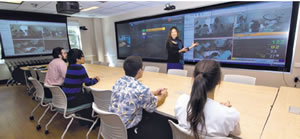Nursing Capital of The Pacific
A cutting edge, $8 million teaching facility that opens in Webster Hall this week provides UH nursing students with robotic patients that simulate medical procedure, from childbirth to emergency surgery, redefining world-class and making Manoa the Nursing Capital of The Pacific

By .(JavaScript must be enabled to view this email address)
E-mail this story | Print this page | Archive | RSS |
 Del.icio.us
Del.icio.us
|
What students experience here, restaging actual patient situations, translates into what they will do on the job and do so with critical thinking and confidence.
As UH envisions its leadership position as the “hub of quality health care,” it does so with the help of Hawaii’s top stakeholders in the field. Recognizing the opportunity “they got it” founding partners of the venture are HMSA Foundation, Hawaii Pacific Health, The Queen’s Medical Center and Kaiser Permanente Hawaii. Support also comes from First Hawaiian Bank and J.M. Long Foundation.
“Our simulation center was designed after Hawaii’s leading health care agencies and best practices in nursing education,” says Lorrie Wong, Ph.D., associate professor and director of THSSC.
There are seven simulation rooms with high-fidelity manikins (medical mannequins) playing the part of patients. In these fully equipped rooms, including professional medical apparatus, are staged emergency/trauma cases, childbirth labor and delivery, adult intensive care, neonatal intensive care, pediatric intensive care and a homecare setting.
There also is an eight-bed inpatient unit and adjacent two-bed unit with bedside electronic health records and mid-fidelity manikins. Three outpatient rooms, three research labs, a high-tech computerization and audio-visual control room, and four debriefing rooms complete the structure. The state-of-the-art facility can accommodate up to 190 people.
A large conference room has an impressive 6-by-25-foot LCD screen the multiscreen wall panel would make any Monday Night Football fan envious. It is used for telemedicine and telecommunications applications with Neighbor Island campuses and Pacific communities such as Guam and Micronesia.
Primary users of the center are UH nursing students, faculty, researchers and practicing nurses from the community.
Rather than practicing procedures on actual patients, although actors are used occasionally, nursing students work with life-sized anatomical human models. These are three-dimensional, computerized models of human beings, created for medical instructional purposes.

|
These high fidelity manikins, like the bionic Six Million Dollar Man, are electromechanically wired. Incidentally, it is indeed spelled m-a-n-i-k-i-n-s, not mannequins like the ones you find in store windows.
If you didn’t know any better, meeting a manikin can be a startling experience.
As we meet “Mr. Kahui” in the trauma room, we examine his pulse, feel the palpitations in his chest, observe bleeding from his face and body, wipe sweat from his forehead, trace his eye movements and even hear him speak.
In the birthing suite, manikin “Noelle” can simulate complications from childbirth, including hemorrhaging, breeched delivery and umbilical cord compression.
“This is a safe environment for learning where one can make a mistake and learn from it,” says Wong. “These scenarios give the experience, but the real learning takes place in the debriefing room, where students view instant-replay video and evaluate their performance. They do this without the pressure of testing or grading. It’s all about the dialogue. Once they make a mistake in simulation, they are less likely to repeat it in clinical practice.”
Dean Boland adds, “Health care providers are perfectionists by nature. But they operate in a culture that tends to be quite punitive. Mistakes and malpractice are constant concerns.
“When you look at where health care goes wrong, it tends to be errors in care delivery, medication administering, and communication,” she says. “Role-playing and learning from colleagues in an interactive way are basic to building best practices and narrowing the margin of error.”
The planning, development and construction of UH’s nursing simulation center has been a two-year fast-track dream come true.
“But this is just the beginning,” says Wong, a Kailua High and UH graduate who has been a university educator for 22 years. “There is so much we can do with simulation learning. We have taken the first steps toward a bigger vision.”
Ah, yes, the big picture.
But why should anyone care? After all, isn’t this all just a grand lesson for nurses in proper bedside manner?
Boland loves tough questions like that, especially when you use the word “care.”
She responds, “Health care touches everyone. At some time, each of us or someone in our family needs professional health care. The lay person really cannot judge good or poor care. They just have to trust that care is good. If that trust breaks down, patients seek solutions elsewhere.
“There is an unspoken sense in Hawaii that to get good care, you have to go the Mainland,” she says. “The university, along with the community’s medical professions, is building the capacity for quality care. Whether it is educating aspiring nurses or retooling skills of practicing nurses, we are confident in our facility and look forward to utilizing this tremendous resource for the betterment of the local health care industry.”
Factored into that big picture is a rapidly aging population, a health care system that must annually absorb millions of newly insured patients, and a third of current physicians about to retire over the next decade.
Industry observers say in all the discussions about adjusting the number of medical schools and training slots, rearranging physician payment schedules and reorganizing practice models, one group of providers has been conspicuously missing: nurses.
Nurses currently form the largest sector of health care providers, with more than 3 million currently registered. The handmaiden relationship of nurses to doctors, they say, is outmoded.
Change is in the wind. The UH nursing simulation center is part of that change. It’s a breath of fresh air.
Page 2 of 2 pages for this story < 1 2
E-mail this story | Print this page | Comments (0) | Archive | RSS
Most Recent Comment(s):








